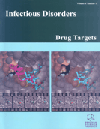-
s Challenges in Engendering Herd Immunity to SARS-CoV-2 Infection: Possibly Impossible But Plausibile
- Source: Infectious Disorders - Drug Targets, Volume 22, Issue 4, Jun 2022, p. 1 - 3
-
- 01 Jun 2022
Abstract
Herd immunity can only be achieved when it is extended to the population level. When a sufficiently significant fraction of immune individuals exists in a group, it confers indirect protection from infection to vulnerable individuals. This population-level effect is frequently considered in the context of vaccination programs, which attempt to build herd immunity so that people who cannot be vaccinated, such as the very young or those with impaired immune systems, are nonetheless protected from disease. Clinical signs are at times poor predictor of transmissibility for some infections, such as COVID-19, because asymptomatic hosts can be extremely infectious and contribute to the spread of the virus. COVID-19 is a quickly evolving issue that has been widely spread throughout the world. This article elaborates the idea and goal of herd immunity, the necessary conditions for realizing herd immunity, the restrictive requirements for applying herd immunity, and the obstacles experienced in achieving herd immunity in the context of COVID-19. This mini-article explains the concept and purpose of herd immunization in the context of COVID-19.


